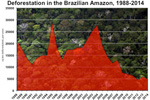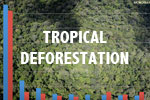Annual deforestation emissions estimates released by the FAO

Deforestation in Borneo. Photo by Rhett A. Butler.
The United Nations Food and Agriculture Organization (FAO) has launched a global set of statistics on carbon emissions from deforestation, agriculture and other forms of land use for the 1990-2010 period.
The dataset, which is part of the FAO’s database of statistics known as FAOSTAT, is based on FAO estimates of forest biomass, deforestation, and crop cover. The data is listed by country and region.
Unsurprisingly, the FAOSTAT GHG dataset shows that high deforestation countries generated the most emissions from forest loss over the 20-year period. Net forest conversion in Brazil released 25.8 billion metric tons of carbon dioxide equivalent (CO2e) between 1990 and 2010. Indonesia (13.1 billion tons), Nigeria (3.8 billion tons), Democratic Republic of the Congo (3 billion tons), and Venezuela (2.6 billion tons) rounded out the top five among emitters, according to the system.


At the other end of the scale, was China, where afforestation, reforestation, and recovery of 5.2 million hectares of forest resulted in the net sequestration of 5.7 billion tons of CO2e. The United States (1.9 billion tons) and Vietnam (1.2 billion tons) also experienced substantial recovery of forest carbon stocks, according to the database.
The database also estimates net emissions from cropland expansion into drained organic soils. Indonesia led the pack with 5.6 billion tons of CO2 emissions, followed by the United States (1.4 billion tons), Papua New Guinea (816 million tons), Malaysia (690 billion tons), and Bangladesh (612 million tons). Emissions in Indonesia, Papua New Guinea, and Malaysia were especially high due to drainage and conversion of carbon-dense peat swamps.
In aggregate, Brazil (25.8 billion tons) and Indonesia (18.7 billion tons) came out on top in terms of emissions from land use. Their combined emissions during the 20-year period are equivalent to about 134 percent of current annual CO2 emissions from fossil fuels or four-and-a-half times China’s 2011 emissions.

While the database provides some interesting insights on the climate impacts of land use change, it comes with a significant caveat: many researchers have criticized the accuracy of FAO data, much of which is self-reported by countries. In particular, annual forest cover data and carbon stock estimates for tropical peatlands are suspect.
Nonetheless, the database is presently the most comprehensive global time-series statistics on greenhouse gas emissions from land-use change and should provide researchers and analysts with a starting point for emissions accounting efforts.
Recent studies indicate that deforestation accounts for roughly 10 percent of global greenhouse gas emissions from human activities. Agriculture and degradation of peatlands contribute a lesser — but more hotly contested — amount of emissions.
Related articles
(02/08/2013) Faster plant growth due to higher concentrations of carbon dioxide may offset increased emissions from forest die-off in the tropics, claims a new study based on climate modeling.
Tropical deforestation emissions were 3 billion tons/yr from 2000-2005
(12/03/2012) Two prominent groups of researchers have reached a consensus estimate for emissions from tropical deforestation between 2000 and 2005.
Indonesia lost 8.8m ha of forest in the 2000s, generating 7 billion tons of CO2
(12/02/2012) Indonesia’s greenhouse gas emissions from deforestation could have been reduced by hundreds of millions of tons had a moratorium on new concessions in high carbon forest areas and peatlands been implemented earlier, reported a researcher presenting at a forests conference on the sideline of climate talks in Doha.
Brazil’s deforestation at record low from 2011-2012

(11/27/2012) Deforestation in the Brazilian Amazon fell to the lowest rate since annual record-keeping began in 1988 according to provisional data released Tuesday by Brazil’s National Space Research Agency (INPE). 1,798 square miles (4,656 square kilometers) of Amazon forest was chopped down during the 12 months ending July 31, 2012, 27 percent less than the year earlier period.
Deforestation accounts for 10 percent of global carbon emissions, argues new study

(06/21/2012) Tropical deforestation accounted for 10 percent of global carbon dioxide emissions between 2000-2005 — a substantially smaller proportion than previously estimated — argues a new study published in Science. The paper estimates gross carbon emissions from deforestation at 810 million metric tons (with a 90 percent confidence interval of 0.57-1.22 billion tons) per year from 2000-2005, significantly below earlier calculations. Brazil and Indonesia accounted for 55 percent of gross emissions from tropical deforestation during the study period, while dry forests accounted for 40 percent of tropical forest loss but amounted to only 17 percent of emissions.
Emissions from deforestation depend on fate of cleared trees
(05/14/2012) Carbon emissions from deforestation vary greatly depending on whether timber stocks are turned into finished wood products, converted into bioenergy feedstocks, or burned outright, reports a new study published in Nature Climate Change.
Rainforests store 229 billion tons of carbon globally finds new ‘wall-to-wall’ carbon map

(01/30/2012) Tropical rainforests store some 229 billion tons of carbon in their vegetation — about 20 percent more than previously estimated — finds a new satellite-based assessment published in the journal Nature Climate Change. The findings could help improve the accuracy of reporting CO2 emissions reductions under the proposed REDD program, which aims to compensate tropical countries for cutting deforestation, forest degradation, and peatlands destruction.







